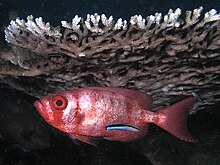Cleaning symbiosis
Cleaning symbiosis is a mutually beneficial association between individuals of two species, where one (the cleaner) removes and eats parasites and other materials from the surface of the other (the client).
[6] Marine biologist Alexandra Grutter explains:[7] Cleaning associations involve cleaner organisms that remove ectoparasites and other material, such as mucus, scales and skin, from the body surfaces of other apparently co-operating animals.
Cleaning behaviour is one of the most highly developed inter-specific communication systems known, with clients striking elaborate postures which have generally been assumed to make ectoparasites more accessible to cleaners.
[6] They quote as an example of an early position, C. Limbaugh writing in 1961: "From the standpoint of the philosopher of biology, the extent of cleaning behavior in the ocean emphasizes the role of co-operation in nature as opposed to the tooth-and-claw struggle for existence".
[6] In 1971, mathematical biologist Robert Trivers wrote more carefully "Cleaner organisms and their hosts meet the preconditions for the evolution of reciprocally altruistic behavior.
[6] By 1987, G. S. Losey wrote less optimistically "Cleaners are nothing but very clever behavioral parasites ... that have taken advantage of the rewarding aspects of tactile stimulation, found in nearly all vertebrates.
"[6] Poulin and Grutter remark that "Over the last few decades, ... the opinion of scientists regarding cleaning symbioses has changed, from selfless cooperation, to a mutually beneficial interaction, and finally to a one-sided exploitation.
[28] However, instead of providing the cleaning service that it signals, it bites off pieces of healthy skin, scales and mucus from the host and then swims rapidly away to safety.
"[30] The fangblenny has evolved an opioid-containing venom which dulls pain and lowers blood pressure, confusing the bitten host and giving the cheating mimic time to escape.



